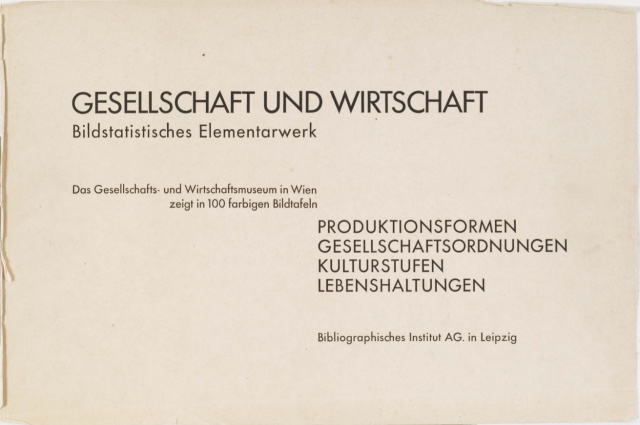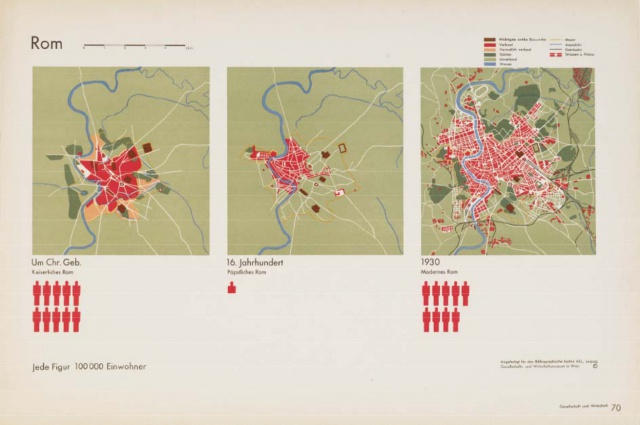Gerd Arntz, Otto Neurath, et al.: Gesellschaft und Wirtschaft: Bildstatistisches Elementarwerk (1930) [German]
Filed under book | Tags: · data visualisation, economy, graphic design, infographics, society, statistics

Economy and Society: Elementary Pictorial Statistics is an early example of socially-engaged piece of graphic design. The work was commissioned by the Bibliographical Institute in Leipzig, an important publisher of reference works and dictionaries, to the political economist and Vienna Circle philosopher Otto Neurath and his initiative, the Museum of Society and Economy.
The city-funded Museum was conceived as an institution for informing the public about the results of sociological and economical research. It staffed Marie Reidemeister, the University of Göttingen educated mathematician, Josef Jodlbauer and others. Since 1928 they also worked with graphic artist and council communist Gerd Arntz. The team developed their own method of visual education, picture statistics, hoping to ensure that even “passers-by [..] can acquaint themselves with the latest sociological and economical facts at a glance,” and later to become known as Isotype.
Economy and Society was made as a collection of one hundred statistical charts printed on loose leaves, depicting the state of world affairs of their day, with thirty text tables of source statistics included in an appendix.
“Isotype was conceived as a picture language for teaching purposes and as a lingua franca, not a universal code. Its signs were constructed as clearly as possible in themselves, so they could be used without the help of words. The signs were arranged into ‘fact pictures’ according to certain rules, which were set up by a ‘chief organization’ – as Neurath called his workrooms at The Hague. Thus a picture language emerged from the consistent use of expert graphic design. Its elements or pictograms were reduced to the smallest possible detail of what they represented, for example starting with the outline of a ‘man’, and if necessary, adding attributes to identify the man as a ‘worker’, a ‘coal miner’ or an ‘unemployed person’, and so on. Perspective was abandoned in the pictures, illustrating details were banned and any use of colors would be standardized. Starting with Gesellschaft und Wirtschaft, the picture books produced show the struggle to build up a visual system of rules and signs. As its goal, Neurath identified the ‘education of public opinion’ and, on the utopian level, access to knowledge for all: ‘The Isotype picture language would be of use as a helping language in an international encyclopaedia of common knowledge’.” (this paragraph is taken from Frank Hartmann, Humanization of Knowledge Through the Eye, 2005)
Elementarwerk. Das Gesellschafts- und Wirtschaftsmuseum in Wien zeigt in 100 farbigen Bildtafeln Produktionsformen, Gesellschaftsordnungen, Kulturstufen, Lebenshaltungen
Publisher Bibliographisches Institut, Leipzig, 1930
130 leaves
via Libcom.org
Commentaries: Nader Vossoughian (2003), Sybilla Nikolow (2006), Ed Annink and Max Bruinsma (n.d.), Robin Kinross (2008).
PDF (15 MB)
See also International Picture Language: The First Rules of Isotype, 1936
Comment (0)David Freedberg: The Eye of the Lynx: Galileo, His Friends, and the Beginnings of Modern Natural History (2002)
Filed under book | Tags: · animal, art history, astronomy, botany, data visualisation, empiricism, history of science, image, natural history, nature, plants

“Some years ago, David Freedberg opened a dusty cupboard at Windsor Castle and discovered hundreds of vividly colored, masterfully precise drawings of all sorts of plants and animals from the Old and New Worlds. Coming upon thousands more drawings like them across Europe, Freedberg finally traced them all back to a little-known scientific organization from seventeenth-century Italy called the Academy of Linceans (or Lynxes).
Founded by Prince Federico Cesi in 1603, the Linceans took as their task nothing less than the documentation and classification of all of nature in pictorial form. In this first book-length study of the Linceans to appear in English, Freedberg focuses especially on their unprecedented use of drawings based on microscopic observation and other new techniques of visualization. Where previous thinkers had classified objects based mainly on similarities of external appearance, the Linceans instead turned increasingly to sectioning, dissection, and observation of internal structures. They applied their new research techniques to an incredible variety of subjects, from the objects in the heavens studied by their most famous (and infamous) member Galileo Galilei—whom they supported at the most critical moments of his career—to the flora and fauna of Mexico, bees, fossils, and the reproduction of plants and fungi. But by demonstrating the inadequacy of surface structures for ordering the world, the Linceans unwittingly planted the seeds for the demise of their own favorite method—visual description-as a mode of scientific classification.
Profusely illustrated and engagingly written, Eye of the Lynx uncovers a crucial episode in the development of visual representation and natural history. And perhaps as important, it offers readers a dazzling array of early modern drawings, from magnificently depicted birds and flowers to frogs in amber, monstrously misshapen citrus fruits, and more.”
Publisher University of Chicago Press, 2002
ISBN 0226261476, 9780226261478
513 pages
Review (Peter Campbell, London Review of Books)
Review (Eileen Reeves, The Art Bulletin)
Review (Pamela O. Long, Technology and Culture)
Review (Steven F. Ostrow, The International History Review)
Review (The New York Review of Books)
Review (PD Smith, The Guardian)
PDF (134 MB, updated on 2016-9-18)
Comment (0)Stephen Wright (ed.): Dataesthetics: How to Do Things with Data (2006) [English/Croatian]
Filed under book | Tags: · art, biopolitics, cartography, data visualisation, database

Data has become the most pervasive and intangibly invasive feature of contemporary life; of life become data. Life systems have been the object of sustained data gathering since the time of the Enlightement, and cartography, flow charts, graphs and statistical databases have played a preponderant role in the shift from a society based on discipline to contemporary regimes of biopolitical control.
Art production long sought to protect the relatively autonomous sphere it had eked out for itself from any incursion by the potentially deadening logic of knowledge production and data gathering and display. In the face of the sheer glut and facile allure of purpose-driven information and rationality, art`s self-assigned role was to affirm its radical uselessness.
Yet as knowledge use has become inseparable from the exercise of power, many practitioners have chosen to use the strength of data to challenge and potentially subvert data-power. Critical cartography, tactical magic, database use and research have become integral components of artistic competence, which refuses to leave social critique to the social sciences.
With contributions by Bureau d’Etudes, Media Farzin, Rene Gabri, Aaron Gach, Brian Holmes, Naeem Mohaiemen / Visible Collective, Trevor Paglen, Nataša Petrešin, Martha Rosler, Gregory Sholette, McKenzie Wark, Stephen Wright.
Publisher Arkzin, Zagreb; with Revolver, Frankfurt; and WHW, Zagreb, 2006
Creative Commons Attribution-Share Alike 2.5 License
ISBN 9536542854, 3865883699
184 pages


